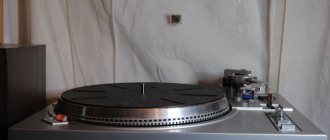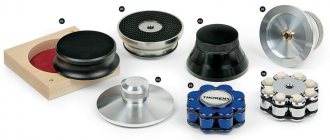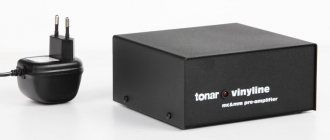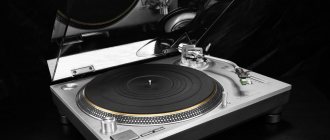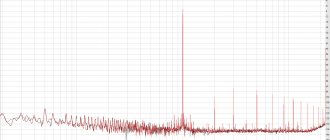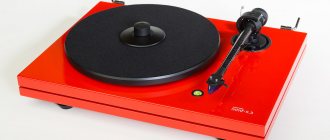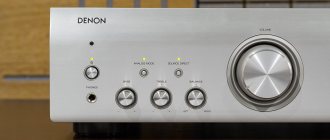And I listened to it on vinyl. Yes, now you can say that too.
Records will never go away. Various audio recording media come and go, but vinyl is forever. This is history, a whole era, when people stood in huge lines to buy records, and X-rays were used to copy records.
And it is not surprising that almost every home has cardboard envelopes with the “Melody” logo, which are treasured by the older generation. With the development of technology, we are surrounded by “digital”. Torrents try to deceive us with uncompressed audio formats and, filling our hard drive with files, we think: “This is quality! Now I know what pleasure is.”
But that's not true.
Just like many, many years ago, you just have to turn on the vinyl player, take out a black round piece from a slightly worn paper envelope, run a cloth over it, wiping off microscopic dust particles, and carefully lower the tonearm. No flacs/alaks can compare with the sound of a vinyl record, and time is the best proof of this. Vinyl will never go away.
The trouble is that in our time this is a pleasure for the wealthy - equipment for listening to records usually costs a lot of money. It’s all the more pleasant that the leading manufacturer of audio equipment, the Audio-Technica , produces, among others, high-quality “turntables” for vinyl lovers, the purchase of which will not put a big dent in your wallet. AT-LP5 , excellent in terms of price/quality ratio .
Design and technology
The Audio-Technica AT-LP5 is a full-size turntable that does not have a belt drive. The motor drives the platter directly, which significantly increases the level of stability and accuracy of tone and eliminates jerks in torque. There is an opinion that the operation of a direct drive, unlike a belt drive, creates extraneous noise that can be read by a needle, transmitted to the cartridge and then through the sound output device (speakers or headphones) to spoil the listener’s mood.
These concerns exist due to unscrupulous manufacturers who use cheap motors and materials. The AT-LP5 is fine with this: no extraneous noise from the operation of the motor or support disk was noticed during testing.
The player also has thick rubber feet-washers with massive metal inserts, with the help of which the problem of resonance is reduced to almost zero. There are a minimum of control elements - one vernier, which allows you to accelerate the support disk to 33 or 45 revolutions per minute. Again, thanks to the beltless drive, acceleration takes just 2 seconds.
Instead of a straight one, Audio-Technica installed a J-shaped rotating tonearm. For reference: this important element can be straight or curved, as well as rotary or tangential. There are different points of view on which tonearm shape is preferable. Theoretically, a curved tonearm, due to its length, has a lower resonant frequency, which should have a good effect on sound quality. And in the AT-LP5 , the AT-HS10 with double moving magnet AT95EX is also responsible for the sound quality .
This wealth is included immediately in the kit, and when the owner improves his “skill”, you can easily replace the head with all the filling with a more advanced one, without skimping on funds.
Despite the relatively low cost of the player, the engineers pleased us with some rare “tricks”. For example, the tonearm is equipped with a hydraulic damping mechanism (this is cool), as well as an anti-slip regulator and a convenient, adjustable counterweight (this is a classic). The counterweight included in the kit is designed for a range from 0 to 5 grams, which allows you to easily use it for heads weighing 7-8 grams.
Sound
To evaluate musical abilities, I connected the player to two systems that were completely different in their level. In the first case, I used an inexpensive Yamaha music center with standard acoustics, and in the second, a serious but small stereo system based on a Luxman tube amplifier.
In an entry-level system, the player performed completely predictably. The warm “vinyl” musical picture was revealed through the prism of a budget music center. The sound character is unique; the listener will have the opportunity to experience all the charm of an analog source, but such a system is far from fully listening to vinyl.
In the case of the Luxman, I used the turntable's stock phono stage paired with a basic Audio-Technica AT95X head. Despite the budget class of the pickup, I heard a good level of tonal balance. Regardless of musical genres, the player demonstrated a confident and reliable mid-range. There is sometimes some harshness in the upper frequencies, especially on records released today. The bass level is moderate, there is volume, but sometimes it lacks attack speed. Similar sound features are typical for budget pickups, but given the thoughtful design of the player, you can install a higher-class cartridge and significantly improve the sound quality.
“One more thing”
A nice bonus for the owner - the AT-LP5 has its own USB port for digitizing albums via a direct connection to a computer. I already wrote at the very beginning that digital recordings cannot be compared with analogue ones, but if a vinyl rarity is gathering dust in the bins of a closet, for which there is no digital analogue on the Internet, it makes sense to immortalize such a masterpiece in digital form.
Special software (something like Audacity) will help with this, the disc with which is carefully placed in the box along with the player. All vinyl recordings can be transferred to your electronic collection with compression parameters of 16 bit / 48 kHz, which quite claims to be an excellent result.
Many modern audio amplifiers do not have a built-in phono stage. Therefore, a cable with RCA connectors can be soldered into a vinyl player without a phono stage. This is due to the fact that the signal coming from the pickup is very weak (a phono stage is required to amplify it), and to prevent signal loss at the junction of the cable and the socket, the cable is soldered on one side into the player.
The disadvantage of such a non-removable cable is its fixed length (insufficient or, conversely, excessive) and the impossibility of simple replacement with a better cable. Replacing the cable is only possible with a soldering iron, straight hands and with the possible loss of warranty.
What I mean is that the AT-LP5 has its own built-in preamplifier (phono stage), so it can be connected to any hi-fi system amplifier without any problems. The RCA cable is included and can be easily replaced with a more advanced one, with graphite damping chips and other tricks for maximum sound transmission effect.
Easy assembly
The player comes almost fully assembled. The installation and basic setup process will take approximately 15-20 minutes for an untrained person. Before you start using the player, you will have to install the disc, rubber mat, adjust the tonearm and set the clamping force with anti-skating. The turntable table is equipped with adjustable legs, with their help it is necessary to ensure a horizontal and stable position of the turntable. In my opinion, the legs are quite soft, this is acceptable for direct drive, but I still recommend installing the player on the hardest possible surface.
The entire assembly and configuration process is described in detail in the Russian-language instructions. Remember that a turntable is largely a mechanical system. Pay maximum attention to the geometry (everything should be smooth) and setting up the tonearm, as a result, you will get a high-quality and warm vinyl sound.
No amp? No problem!
For the purity of the experiment, I used the player’s built-in phono preamplifier and simply connected it with the supplied RCA wires to a Behringer analog mixing console, into which I plugged in headphones. I boldly declare: this is also possible! The AT-LP5 did not disappoint - the signal was strong enough to drive all the headphones I found in the house, including the amazing Astell&Kern AK T1p, which I wrote about recently.
Today is a great day to listen to all the vinyl stock! #vinyl #warm tube sound #over the moon #me #moscow #mood #astellnkern #audiotechnica #turntables #discs spinning #rock
Photo posted by Mick Sid (@mickmaster) Jan 22 2016 at 4:01 PST
So what is this - a tribute to antiquity or a new trend?
Modern vinyl record players have both adherents and uncompromising opponents, with the latter insisting that real sound is only possible through mechanical reproduction, and that the artist on the cover must be viewed with the help of a kerosene lamp.
Is it really? If there are such unique individuals, then, probably, everything is individual. But even if you give such people a Bon Jovi record to listen to on a Friday night, they are unlikely to resist. Many hits of the last century have not been preserved in the best condition, but on vinyl they sound almost exactly as they did 50-60 years ago. Perhaps you still need to grow up to buy vinyl, but the AT-LP3 model from Audio-Technica is exactly the one with which you can start your journey, because similar solutions on the market are, if not an order of magnitude, more expensive.
PS
There is a legend that the famous game “Field of Miracles” (more precisely, its American analogue) came to the creator’s mind while listening to the record. So, gentlemen, spin the vinyl drum!
Impressions of the sound
Despite the lack of a separate amplifier, the sound is amazing. It feels like the player “out of the box” has a high-quality cartridge, and all the other internal components are excellent. Good detail, mids and highs are smooth and open, without being harsh or compressed. The scene sounds broad, I would say even deep, with clearly defined images and separated plans. There is a unity of sound and its detail, but without any harshness.
With emotional presentation, everything is just fine - what the performer or the work wanted to convey is what is felt.
Digitization included
So, we have before us a device that is clearly aimed at young, progressive and, most likely, completely inexperienced music lovers in terms of analog sound reproduction. And if so, then its indispensable attributes are an affordable price, a complete sound pickup and a built-in phono preamplifier, and in our case also an internal ADC with a USB interface and Audacity software for digitizing records.
By the way, vinyl-maniacal snobbery aside, this thing is not so useless. Having bought an interesting disc for the occasion, you can “cut” it for listening on the same mobile phone. Although I would, of course, just go to the tracker and download the desired release from there without any qualms - since I already paid for it anyway. It would have turned out faster and almost certainly much better. However, we won’t completely discount the chance of obtaining a particularly exotic publication that is not available in torrent communities.
There are a lot of buttons and icons in the window, but basic computer skills are enough to work with the program
There is another scenario - saving family values, that is, records stored on shelves for many years (or even decades). Mostly, of course, for children. And often this is done by people who are not familiar with any torrents in principle.
